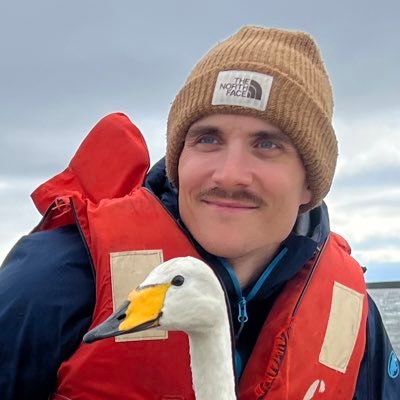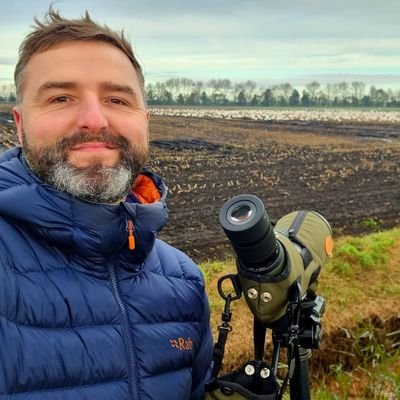
Stephen Vickers
@Stephen8Vickers
Followers
2K
Following
11K
Media
1K
Statuses
4K
Ecological Statistician at BioSS . ‘S’ permit bird ringer & RIN member 2022-26.
Edinburgh, Scotland
Joined March 2011
You can now find links and introductions to all of my #RShiny apps here: https://t.co/av37hFTpcF Recommendations for improvements or entirely new apps are welcomed.
1
4
31
The Whoopers are starting to move and will soon be back on their Icelandic breeding grounds! Since @WaterbirdCM started ringing Whoopers in 2023, we've tagged >600 inds. and gathered >750 sightings. Please keep an eye out and continue to report any sightings to us as they leave!
1
24
83
In Feb 23 we undertook a census of the UK naturalised Barnacle Goose population. The aim to produce an updated population estimate & report on winter distribution. Results have now been published in @BritishBirds, with our thinking on future monitoring needs #Ornithology 1/7 ⬇️
3
22
80
A special thanks to my co-authors and funders. This work was completed as part of my PhD thesis at @biouea/@ueaenv/@uniofeastanglia partnered with @audubonsociety 10/10
0
0
0
We think this is because dispersal into new breeding areas is always passed to the next generation when born there – you only need to return to a known location. Conversely, a new non-breeding site isn’t automatically passed to the next generation. 9/10
1
0
0
Flocking was associated with significantly larger non-breeding range COA shift rates, particularly in mixed-age flocks. However, flocking had no significant effect on breeding range COA shifts. 8/10
1
0
0
The data goes into PGLS models weighted by uncertainty in COA shift rate. One model for each season for a binary flocking var. for 122 species. Another model for each season where we categorise flocks as either age-separated or mixed-age, for 81 species. 7/10
1
0
0
N.B.: We do still lack published accounts of typical migratory flocking behaviour for many species! This includes whether a species flocks, typical flock size, age composition, species composition, etc. 6/10
1
0
0
We collated information on migratory flocking behaviour of North American migratory birds, building upon the Beauchamp et al. 2011 dataset with species accounts from Birds of the World Online and age-cohort timing calculated from USGS banding data. 5/10
1
0
0
To test this, we used 50-years of North American BBS and CBC #citizenscience data to quantify annual centres of abundance (COA) for breeding and non-breeding ranges across the contiguous USA and southern Canada. We then summarised the magnitude of the shift in COAs. 4/10
1
0
0
We hypothesised in sp. that migrate solo, inter-generational change may need change in genetics of mig. distance/direction. However, flocking migrants can benefit from social learning, which might act faster – but inter-gen. learning can only happen in mixed-age flocks! 3/10
1
0
0
Species may need to shift their range to respond to environmental change, but for migrants this can be tricky as seasonal ranges that shift at different rates/directions can require a change to migratory distance/direction. 2/10
1
0
0
New paper published today in Movement Ecology! We show N. American birds that migrate in flocks have greater long-term non-breeding range shifts, particularly if flocks are mixed-age. We link this to social learning in novel mig. route development. https://t.co/jeiay1SPox 1/10
1
6
8
New paper! If you use time-lapse cameras, this one's for you! Proud of this collaboration with @UEA_CMP's Marcus Jenkins & Michal Mackiewicz to improve object detection for time-lapse imagery using temporal features. 📷🖥️⏲️ Open Access @Sensors_MDPI: https://t.co/jC7dDwJmAw
2
11
26
Seasonal field staff needed for @RSPBScience projects in 2025 - advert live, closing date 12 Jan. Lots of #seabird (and non-seabird) opportunities across the UK! Get in touch if you’d like to know more about the #seabird roles 🌊 🐦 https://t.co/3wYtYUq6wr
app.vacancy-filler.co.uk
https://logos.vacancy-filler.co.uk/RSPB.png
0
27
36
📣PhD position open in our group!📣 Come work on a super fascinating system: partial #migration in European shags. #Fieldwork, #theory and #QuantitativeGenetics are all possible depending on interests. Please spread to good candidates of any nationality!
0
11
16
* picture is from original ringing in 2020, I haven’t recaught it!
0
1
2
1450 days and 4 return migrations later and back just 7km from where I originally caught and ringed it!
Water Pipits continue to show well at Fen Hide @RSPB_Strumpshaw. This ringed bird was ringed by UEA Ringing Group in 2020 at Cantley BF as an adult. This will be a new UK longevity record 🥇. Thanks to @peaceofcakes for the ringing info via the Ringing Group
4
9
163
Ok! Come on let's follow this lot to where they're sleeping tonight... A thread🧵 #Ornithology 1/7
They're heading home to roost & we're following them. Check back later to see what we find 👀 (oh and sound on!) #WhoopWhoop
3
26
240
Since 2023 we've caught & colour-marked nearly 600 Whooper Swans & we need your help to find them! 🧐 Please check any flocks you may see & let us know what you find...
0
15
29
The @_BTO Ringing and NRS report 2023 data has now been added to my visualisation apps: Explore graphs of numbers ringed etc. and NRS records over time: https://t.co/7tYj0omJ6d Explore a map of numbers ringed, etc. by region: https://t.co/iPMMKyiGGr
0
4
18






